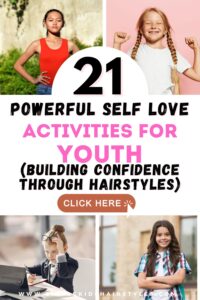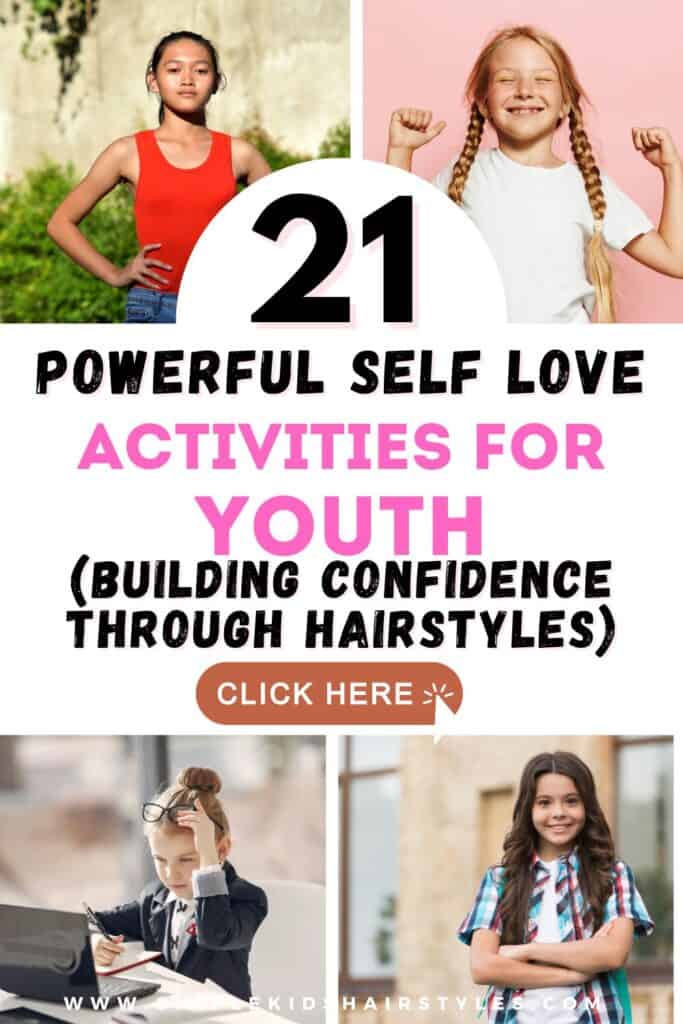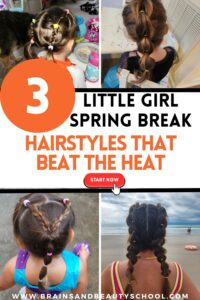Self love activities for youth are a foundational skill for young people navigating their formative years. It helps foster positive thinking, healthy self-esteem, and resilience. Activities that promote self-love can have a lasting impact on mental health and emotional intelligence, especially during the challenging teenage years.
Hairstyling is one simple yet powerful tool that builds confidence. By encouraging creativity and self-expression, it gives young people a tangible way to take control of their appearance. This article explores how hairstyles contribute to self-love, alongside practical self-esteem-building activities for youth.

This post includes affiliate links, which means if you make a purchase through one of these links, I earn a small commission at no extra cost to you. This helps me keep providing high-quality content on this site for free. Rest assured, I only recommend products that I personally use and believe will be helpful for my readers.
Building Confidence with Gratitude Practices
For young adults and teens, cultivating positive self-esteem often starts with focusing on the good things in life. A gratitude journal is a powerful tool to help shift the focus away from negative feelings and towards personal growth. Writing down things they’re thankful for every day encourages them to reflect on positive experiences and achievements, big or small. This practice fosters a sense of optimism and reinforces their self-worth, even on difficult days.
A gratitude journal also provides a safe space for young people to express their emotions and thoughts without judgment. It’s a personal space where they can reflect on new things they’ve learned, whether it’s a new skill, a positive interaction, or simply a good day spent with a good friend. Encouraging your child to take part in this daily activity can significantly boost their confidence by reinforcing a mindset that values the positive over the negative. Over time, this simple practice helps young adults build resilience and strengthens their emotional intelligence.
Moreover, by regularly practicing gratitude, young people begin to view challenges as opportunities for growth. Instead of focusing on mistakes or setbacks, they can shift their mindset to recognize how those experiences contribute to their personal development. This shift is crucial for building confidence and helps young adults embrace their individuality. When they see themselves in a positive light, it enhances their belief in their ability to handle life’s challenges.
Ultimately, teaching your child to embrace gratitude can be one of the best ways to improve their mental health and boost their confidence. By cultivating gratitude, you’re providing them with a tool to manage negative feelings, celebrate good things, and build a strong foundation of self-love. When young adults feel positive and proud of who they are, they become more capable of taking on new things with confidence and resilience.
Why Self-Love is Crucial for Youth
Mental Health and Self-Esteem
Mental health issues are increasingly common among youth, with many experiencing low self-esteem. Appearance often plays a major role, affecting how they view themselves and interact with others. A strong sense of self-worth helps them manage challenges and maintain resilience. When youth develop confidence, they are better equipped to face life’s difficulties and grow emotionally.
Impact of Social Media
Social media often heightens insecurities by promoting unrealistic beauty standards. Teens compare themselves to idealized images, leading to self-doubt and dissatisfaction. This influence makes fostering self-love even more critical during formative years. Activities like hairstyling and positive affirmations help counteract this negativity by promoting self-expression and authenticity.
Fostering a Positive Self-Image
A positive self-image goes beyond appearance, focusing on personal values and achievements. When young people engage in grooming, it reinforces pride in themselves and their unique qualities. Hairstyles provide a creative outlet, allowing them to explore their identity in a healthy way. By blending personal care with self-expression, they learn to value themselves holistically.
Building Resilience Through Self-Love
Practicing self-love equips youth with tools to handle criticism and peer pressure. Activities like hairstyling offer a sense of control over their appearance, boosting confidence in social situations. Emphasizing self-worth builds a solid foundation for emotional well-being. This resilience helps them navigate challenges while maintaining a strong sense of identity.
How Hairstyles Build Confidence
Physical Appearance and Self-Esteem
A well-groomed appearance often leads to higher self-esteem. Hairstyles are not merely about looks; they allow youth to express their creativity and individuality. Experimenting with different styles helps them discover what feels authentic, boosting their confidence. Embracing their unique hair texture or trying new styles fosters self-acceptance and pride in their identity.
Grooming Routines as Self-Care
Daily haircare routines create structure and encourage personal responsibility. Washing, detangling, and styling are small tasks that bring a sense of accomplishment. This process helps youth build discipline and a sense of control over their appearance. Consistent grooming reinforces the idea that taking care of oneself is a meaningful act of self-love.
Positive Reinforcement from Family and Friends
Compliments from family and friends can significantly impact a young person’s confidence. Acknowledging their effort in styling their hair builds a sense of validation. Supportive comments reinforce a positive self-image and encourage further exploration of personal style. This type of encouragement helps create a nurturing environment where they feel valued.
Hair as a Tool for Social Interaction
Hairstyles can spark conversations and help youth connect with peers. Sharing styling tips or discussing haircare routines strengthens social skills. Trying out themed or cultural styles often becomes an opportunity to learn and share experiences. These interactions enhance their confidence in social situations and help them feel more accepted in their community.
@simplekidshairsty 5 simple steps to pigtail french braids!! Step-by-Step Guide Section the Hair: Divide the hair on the left side into three equal sections. Begin Braiding: Cross the right-hand section over the middle, then the left hand section over the new middle. Add Hair: As you braid, add small sections of hair to each strand before crossing it over the middle. Continue Braiding: Repeat the process, adding hair from the left and right sides, until you reach the nape of the neck. Secure the Braid: Use a rubber band to secure the braid at the nape of the neck or continue with a basic French braid down the length of the hair. Repeat on the Other Side: Follow the same steps on the right side.
21 Power Self Love Activities for Youth: Building Confidence Through Hairstyles
1. Try a New Hairstyle Weekly
Encourage youth to explore different hairstyles like braids, buns, or ponytails. This helps them discover styles they feel confident wearing and develops their creative expression.
2. Host a Hairstyling Party
Organize a get-together where friends can teach each other how to create new styles, such as space buns or fishtail braids. This activity builds social skills and strengthens friendships.
3. Incorporate Hair Accessories
Introduce colorful clips, headbands, or ribbons to their daily look. Accessories add personality and make hairstyling fun, boosting confidence through personalization.
4. Create a Haircare Routine
Teach youth to maintain healthy hair by washing, conditioning, and detangling regularly. A consistent routine reinforces discipline and pride in their appearance.
5. Use Positive Affirmations During Styling
Encourage affirmations like “I love taking care of myself” or “My hair is part of my unique beauty” while styling. This builds a positive self-image.
6. Learn a Challenging Hairstyle
Help youth tackle complex styles like Dutch braids or twists. Mastering a skill fosters persistence and creates a sense of achievement.
7. Embrace Natural Hair
Celebrate natural textures by exploring styles suited to their hair type, such as twist-outs or puff balls. This teaches them to embrace their authentic selves.
8. Document Hairstyles in a Journal
Suggest keeping a hair journal with photos and notes about their favorite styles. Reflecting on their progress fosters appreciation for their creativity.
9. Volunteer for a Hair Demo
Encourage participation in local events or tutorials where they can showcase or learn styling techniques. Public engagement builds confidence and public-speaking skills.
10. Pair Hairstyling with a Gratitude Practice
During styling, have them list things they’re grateful for. Gratitude helps shift focus from negative thoughts to positive feelings.
11. Involve Family Members
Let siblings or parents participate in creating styles. Bonding through hairstyling fosters supportive relationships and a sense of belonging.
12. Experiment with Protective Styles
Try long-lasting styles like box braids or Senegalese twists. These low-maintenance options save time and allow them to focus on other self-love activities.
13. Create a Vision Board with Hair Goals
Include hairstyle inspirations on a vision board. Setting goals encourages youth to think about self-expression and self-care as part of their personal growth.
14. Teach Them to Care for Others’ Hair
Let them style a friend’s or sibling’s hair. Helping others fosters empathy and creates mutual support.
15. Explore Cultural Hairstyles
Introduce hairstyles rooted in cultural heritage, such as cornrows or intricate braids. Learning about their history can instill pride in their identity.
16. Incorporate Fun Themes
Suggest seasonal or event-themed hairstyles, such as adding spider clips for Halloween. This makes hairstyling exciting and helps them stand out in social settings.
17. Overcome Hairstyling Challenges
Help youth troubleshoot issues like tangled hair or uneven braids. Problem-solving builds resilience and confidence in handling difficult situations.
18. Teach Self-Care Through Hair Masks
Introduce natural hair masks using ingredients like avocado or honey. Caring for their hair teaches the importance of self-nurturing.
19. Host a Virtual Hairstyling Workshop
Organize a Zoom session where youth learn techniques from a hairstylist or peer. Virtual learning broadens their exposure to new ideas.
20. Celebrate Hair Milestones
When they achieve a goal, like learning to French braid, celebrate their accomplishment. This reinforces the value of hard work and personal growth.
21. Capture Confidence with Photos
Encourage taking pictures after styling to document their progress. Reviewing these images reminds them of how far they’ve come in building self-love and confidence.
These activities integrate hairstyling into self-love practices, equipping youth with creative and emotional tools to boost their confidence.
Top Self Love Activities for Youth Focused on Hairstyles
Creative Hairstyling for Personal Expression
Encourage youth to try hairstyles that reflect their personality. Braids, twists, and ponytails are simple yet impactful choices. For instance, a young person might try French braids with colorful hair ties to express their playful side.
Incorporate accessories like hair beads, bows, or headbands. These additions make hairstyling fun and promote individuality. For special occasions, youth can experiment with elegant styles like fishtail braids or top knots.
Routine Haircare for Positive Outcomes
Help youth develop consistent haircare routines. Washing and moisturizing hair regularly promotes physical appearance and teaches discipline. Incorporating natural DIY hair masks during family bonding time adds a fun, creative element.
Routines also provide an opportunity to discuss healthy self-esteem and body image. Share affirmations like, “I care for myself because I’m worth it,” during these moments to reinforce self-love.
Collaborative Activities with Family or Friends
Host group hairstyling events to create connections and boost confidence. Friends can teach each other new techniques, like box braids or space buns, turning hairstyling into a social activity.
Parents can also bond with their children by helping them learn basic grooming skills. These interactions nurture a supportive environment and provide youth with tools for self-expression.
Challenges to Self-Love and How to Overcome Them
Peer Pressure and Negative Energy
Youth often encounter criticism or teasing about their appearance from peers, which can damage self-esteem. This pressure to conform to societal or peer-group standards fosters insecurity and self-doubt. Encouraging them to focus on their unique qualities helps shift their perspective. Remind them that confidence grows from embracing individuality and not from seeking external validation.
Shifting Focus to Inner Qualities
Many young people prioritize how others perceive them, often at the expense of self-acceptance. Teach them to value their inner traits, such as kindness, creativity, and resilience, above superficial measures. Hairstyles can serve as a way to express these qualities, aligning external appearance with inner character. This balance helps them feel more authentic and self-assured.
Combating Negative Core Beliefs
Negative self-talk can become a barrier to self-love, reinforcing feelings of inadequacy. Encourage youth to identify and challenge harmful beliefs, replacing them with affirming statements. For instance, reframing “I can’t pull off this look” into “I am confident trying styles that feel right for me” builds self-worth. Positive affirmations, practiced daily, can gradually reshape their mindset.
Replacing Criticism with Encouragement
Parents, teachers, and mentors play a key role in helping youth combat negativity. By offering consistent encouragement, they can help young people focus on their strengths. Complimenting effort over appearance—such as the creativity behind a hairstyle—reinforces positive thinking. This external support reinforces internal self-belief.
Growth Mindset and Resilience
Teaching youth to see challenges as opportunities promotes a growth mindset. Struggling with a hairstyle, for example, can build patience and persistence when approached as a learning experience. Celebrate their willingness to try rather than the final result to emphasize personal progress. This approach equips them with tools to overcome other obstacles in life.
Building Confidence Through Experimentation
Encourage young people to step outside their comfort zones with their hair choices. Trying new styles fosters resilience by showing them it’s okay to take risks and learn from failures. Each new attempt reinforces their ability to adapt and grow. This process helps them view setbacks as part of their journey toward confidence and self-love.
FAQ Section Self Love Activities for Youth
1. What are some easy hairstyles for kids that boost confidence?
Simple styles like puff balls, ponytails, or twists are great starting points. Add accessories for a personal touch.
2. How does self-love benefit a child’s mental health?
Self-love reduces stress, boosts resilience, and improves overall mental well-being.
3. What’s the best way to encourage self-love in teens?
Promote positive self-talk, healthy routines, and activities that celebrate individuality, such as hairstyling.
4. How can I help my child manage negative thoughts about their appearance?
Teach them to reframe negative thoughts into affirmations. Remind them that their value isn’t tied to their looks.
5. Can family activities improve self-esteem in youth?
Yes, activities like hairstyling sessions build connections and reinforce a supportive environment.
6. How do hairstyles influence personal growth?
Learning and perfecting new styles fosters patience, creativity, and confidence.
7. What’s the role of physical activity in self-love?
Exercise complements self-love by improving physical and mental health.
Building self-love through hairstyles offers a powerful way for youth to foster confidence and resilience. By allowing them to experiment with different looks, they gain a sense of control over their appearance and can express their individuality. The act of grooming becomes a form of self-care, reinforcing the idea that confidence starts from within. When young people feel good about their hair, they are more likely to feel good about themselves overall.
Despite the challenges posed by peer pressure and negative self-talk, these obstacles can be overcome. Focusing on personal qualities and replacing harmful thoughts with positive affirmations helps shift their mindset. Encouraging youth to embrace their unique traits strengthens their self-worth. As they build confidence, they become more resilient in the face of social pressures and setbacks.
The role of family and friends in reinforcing positive self-image cannot be understated. Compliments and encouragement from loved ones validate a young person’s efforts and bolster their sense of self. This supportive environment fosters emotional growth and nurtures their self-esteem. Acknowledging their efforts in hairstyling or other activities builds trust and confidence in their abilities.
Ultimately, self-love is a journey that requires patience, persistence, and support. Through activities like hairstyling, youth can discover their strengths, develop new skills, and embrace their authentic selves. With the right guidance, they can overcome challenges and cultivate a strong foundation of self-worth. By focusing on both their appearance and inner qualities, they set the stage for lasting confidence and a healthy sense of self.
So, if you’re looking for Thanksgiving trivia questions for kids to ask while you are creating quick and easy hairstyles, give this trivia quiz a try. It’s a win-win for moms and kids on holiday! Don’t forget to share your own tips and favorite hairstyles on Tiktok, Instagram or Pinterest.






